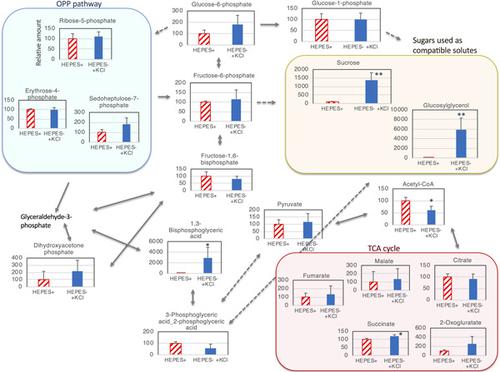当前位置:
X-MOL 学术
›
Biotechnol. Bioeng.
›
论文详情
Our official English website, www.x-mol.net, welcomes your feedback! (Note: you will need to create a separate account there.)
Simultaneous increases in the levels of compatible solutes by cost-effective cultivation of Synechocystis sp. PCC 6803.
Biotechnology and Bioengineering ( IF 3.8 ) Pub Date : 2020-03-15 , DOI: 10.1002/bit.27324 Hiroko Iijima 1 , Atsuko Watanabe 1 , Haruna Sukigara 1 , Tomokazu Shirai 2 , Akihiko Kondo 2, 3 , Takashi Osanai 1
Biotechnology and Bioengineering ( IF 3.8 ) Pub Date : 2020-03-15 , DOI: 10.1002/bit.27324 Hiroko Iijima 1 , Atsuko Watanabe 1 , Haruna Sukigara 1 , Tomokazu Shirai 2 , Akihiko Kondo 2, 3 , Takashi Osanai 1
Affiliation

|
Synechocystis sp. PCC 6803, a cyanobacterium widely used for basic research, is often cultivated in a synthetic medium, BG-11, in the presence of 4-(2-hydroxyethyl)-1-piperazine ethanesulfonic acid (HEPES) or 2-[[1,3-dihydroxy-2-(hydroxymethyl)propan-2-yl]amino]ethanesulfonic acid buffer. Owing to the high cost of HEPES buffer (96.9% of the total cost of BG-11 medium), the biotechnological application of BG-11 is limited. In this study, we cultured Synechocystis sp. PCC 6803 cells in BG-11 medium without HEPES buffer and examined the effects on the primary metabolism. Synechocystis sp. PCC 6803 cells could grow in BG-11 medium without HEPES buffer after adjusting for nitrogen sources and light intensity; the production rate reached 0.54 g cell dry weight·L-1 ·day-1 , exceeding that of commercial cyanobacteria and Synechocystis sp. PCC 6803 cells cultivated under other conditions. The exclusion of HEPES buffer markedly altered the metabolites in the central carbon metabolism; particularly, the levels of compatible solutes, such as sucrose, glucosylglycerol, and glutamate were increased. Although the accumulation of sucrose and glucosylglycerol under high salt conditions is antagonistic to each other, these metabolites accumulated simultaneously in cells grown in the cost-effective medium. Because these metabolites are used in industrial feedstocks, our results reveal the importance of medium composition for the production of metabolites using cyanobacteria.
中文翻译:

通过具有成本效益的集胞藻培养同时增加相容溶质的水平。PCC 6803。
集胞藻属 PCC 6803 是一种广泛用于基础研究的蓝细菌,通常在合成培养基 BG-11 中在 4-(2-羟乙基)-1-哌嗪乙磺酸 (HEPES) 或 2-[[1, 3-二羟基-2-(羟甲基)丙-2-基]氨基]乙磺酸缓冲液。由于 HEPES 缓冲液成本高(占 BG-11 培养基总成本的 96.9%),BG-11 的生物技术应用受到限制。在这项研究中,我们培养了集胞藻。PCC 6803 细胞在不含 HEPES 缓冲液的 BG-11 培养基中,并检查对初级代谢的影响。集胞藻属 PCC 6803细胞在调整氮源和光强后,可以在不含HEPES缓冲液的BG-11培养基中生长;生产速度达到 0.54 g 细胞干重·L-1·day-1,超过商业蓝藻和集胞藻。在其他条件下培养的 PCC 6803 细胞。排除 HEPES 缓冲液显着改变了中心碳代谢中的代谢物;特别是,相容溶质,如蔗糖、葡萄糖基甘油和谷氨酸的含量增加。虽然蔗糖和葡萄糖基甘油在高盐条件下的积累是相互拮抗的,但这些代谢物在经济高效的培养基中生长的细胞中同时积累。由于这些代谢物用于工业原料,我们的结果揭示了培养基组成对于使用蓝藻生产代谢物的重要性。和谷氨酸增加。尽管蔗糖和葡萄糖基甘油在高盐条件下的积累是相互拮抗的,但这些代谢物在经济高效的培养基中生长的细胞中同时积累。由于这些代谢物用于工业原料,我们的结果揭示了培养基组成对于使用蓝藻生产代谢物的重要性。和谷氨酸增加。尽管蔗糖和葡萄糖基甘油在高盐条件下的积累是相互拮抗的,但这些代谢物在经济高效的培养基中生长的细胞中同时积累。由于这些代谢物用于工业原料,我们的结果揭示了培养基组成对于使用蓝藻生产代谢物的重要性。
更新日期:2020-03-15
中文翻译:

通过具有成本效益的集胞藻培养同时增加相容溶质的水平。PCC 6803。
集胞藻属 PCC 6803 是一种广泛用于基础研究的蓝细菌,通常在合成培养基 BG-11 中在 4-(2-羟乙基)-1-哌嗪乙磺酸 (HEPES) 或 2-[[1, 3-二羟基-2-(羟甲基)丙-2-基]氨基]乙磺酸缓冲液。由于 HEPES 缓冲液成本高(占 BG-11 培养基总成本的 96.9%),BG-11 的生物技术应用受到限制。在这项研究中,我们培养了集胞藻。PCC 6803 细胞在不含 HEPES 缓冲液的 BG-11 培养基中,并检查对初级代谢的影响。集胞藻属 PCC 6803细胞在调整氮源和光强后,可以在不含HEPES缓冲液的BG-11培养基中生长;生产速度达到 0.54 g 细胞干重·L-1·day-1,超过商业蓝藻和集胞藻。在其他条件下培养的 PCC 6803 细胞。排除 HEPES 缓冲液显着改变了中心碳代谢中的代谢物;特别是,相容溶质,如蔗糖、葡萄糖基甘油和谷氨酸的含量增加。虽然蔗糖和葡萄糖基甘油在高盐条件下的积累是相互拮抗的,但这些代谢物在经济高效的培养基中生长的细胞中同时积累。由于这些代谢物用于工业原料,我们的结果揭示了培养基组成对于使用蓝藻生产代谢物的重要性。和谷氨酸增加。尽管蔗糖和葡萄糖基甘油在高盐条件下的积累是相互拮抗的,但这些代谢物在经济高效的培养基中生长的细胞中同时积累。由于这些代谢物用于工业原料,我们的结果揭示了培养基组成对于使用蓝藻生产代谢物的重要性。和谷氨酸增加。尽管蔗糖和葡萄糖基甘油在高盐条件下的积累是相互拮抗的,但这些代谢物在经济高效的培养基中生长的细胞中同时积累。由于这些代谢物用于工业原料,我们的结果揭示了培养基组成对于使用蓝藻生产代谢物的重要性。


























 京公网安备 11010802027423号
京公网安备 11010802027423号